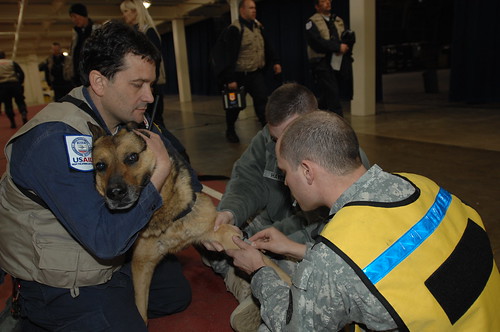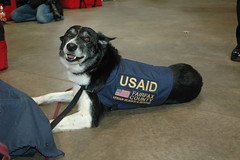Like the rest of the world I’ve been glued to the TV and newsfeeds watching and reading about the devastation caused by the earthquakes and resulting tsunami. The loss of life is staggering, but in tragedies like this I always wonder about the welfare of the animals that are also affected. What happens to the animals whose owners are missing, dead, or injured? Is anyone there to look out for them?
Organizations that provide food, supplies and shelter to aid our fellow human beings start campaigns to gather donations for the cause immediately. Mainstream organizations receive a lot of media attention and donations from the public. The organizations that provide care to our four-legged friends in need are less well-known, but they do exist, and you can help too! I’ve listed just a few of the organizations that are dedicated to helping the furry victims, as well as the furry aid workers, now in Japan.
Ark Bark – This amazing Japanese rescue group is gearing up for the arrival of homeless and displaced pets. They’re hard at work building additional shelters for the large amounts of pets already arriving. You can donate to the cause on their website, just add “for earthquake animals” in the notes.
World Vets– World Vets provides veterinary aid all around the world. They are currently coordinating with other rescue organizations to provide care to Japan’s many lost or injured pets. Donations to the organization are tax deductible.
AKC’s Companion Animal Recovery Canine Support & Relief Fund – Started in the wake of 9/11, this 501C 3 charitable organization’s mission is to fund canine search and rescue teams deployed throughout the world, wherever tragedy strikes. You can donate to their cause through the link above. Remember to note that it is on behalf of Japan.
The Annenberg Foundation – The Dog Bless You project harnessed the power of the Facebook community to donate $100,000 to Japan animal relief efforts. Check out their page here.
Photo credits:The 1st photo was taken on March 13, 2011 in Misawa-shi, Aomori Prefecture, JP, and was posted by The Official US Navy Imagery. The 2nd photo was taken March 11, 2011 and was posted by Fairfax County
 That Pet Blog That Pet Place Pet Blog
That Pet Blog That Pet Place Pet Blog







 The experience has taught me a few lessons, mainly that some dogs really can (and will) eat anything if given the opportunity. I was always very careful about leaving things out or leaving doors open before, but (lesson #2) dogs can be very sneaky. Finally, I learned that both my dogs are integral parts of my life and that when it comes down to the wire I would do anything to make their lives long, healthy, and happy.
The experience has taught me a few lessons, mainly that some dogs really can (and will) eat anything if given the opportunity. I was always very careful about leaving things out or leaving doors open before, but (lesson #2) dogs can be very sneaky. Finally, I learned that both my dogs are integral parts of my life and that when it comes down to the wire I would do anything to make their lives long, healthy, and happy.